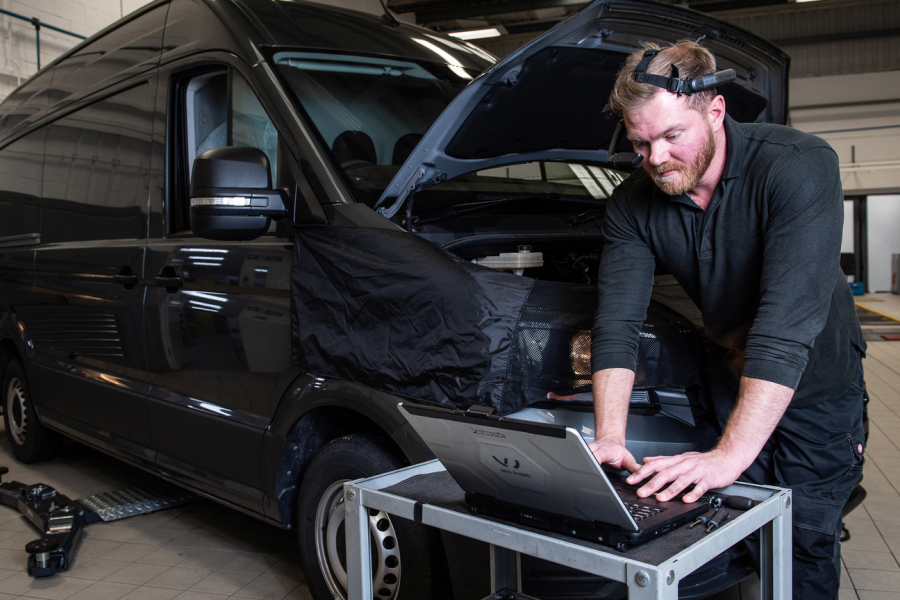Burns & McDonnell Streamlines Utilities
Burns & McDonnell reduces travel needs and improves site testing processes using
assisted reality technology.

Burns & McDonnell is an engineering, consulting and construction firm. Its 7,000 engineers, architects, construction professionals, scientists, consultants and entrepreneurs support clients around the world.

The Challenge
Experienced workers were being stretched thin, resulting in wider knowledge gaps and slower site visitations and distribution asset documentation.
The Solution
Assisted reality technology with RealWear and VisualSpection streamlines site documentation and enables Burns & McDonnell’s senior experts to virtually visit and review sites without traveling.
The Results
- Reduced field errors by 33%
- Enabled experienced employees to monitor multiple sites
- Distributed asset documentation can be completed five times faster
Hands-Free Use Case
- Distribution asset documentation
Burns & McDonnell has been planning, designing, permitting, constructing and managing projects worldwide since 1898. A key factor in the firm’s longevity is treating its clients’ projects as if they were its own. While this attention to detail was great for clients, the dedication was taxing. With projects all over the world, Burns & McDonnell’s high-level technical experts needed to travel to sign off on multiple phases of development at each
individual site.
The firm also wanted to improve how site evaluations were completed. Traditionally, the field worker would capture asset information and document it by GPS locations on paper. They would then bring that data back to the office to sort and enter into a database.
As a leader in the utilities industry, Burns & McDonnell wanted to continue innovating.
The Right Tools for the Job
Hardware Requirements
- Safe for field use, including PPE compatible and hands-free
- Field-ready
- Long battery life
AR Software Requirements
- Doesn’t distract worker
- User friendly
- Cost-effective
- Can send and receive information
- Scalable
Ultimately, Burns & McDonnell chose RealWear headsets to run Manitoba Hydro International’s (MHI) VisualSpection application.

The RealWear HMT-1 headset was specifically chosen because it met and exceeded the hardware requirements:
- Safety: The headset clipped directly onto hardhats and can be worn with eye protection.
- Designed for field use: The HMT-1 is shock resistant and rated IP66 for dust and water resistance.
- Long-lasting charge: The battery can last up to 10 hours with normal use and can be swapped out with a fresh
battery in the field.
While researching RealWear, Burns & McDonnell discovered the other benefits of the HMT-1 device:
- Familiarity: The HMT-1 is essentially an Android tablet device but in a wearable headset form.
- Hands-free: : Instead of handling a tablet, wearers can view content on the high-resolution micro-display. The display is positioned in the wearer’s line of sight without impeding field of view.
- User-friendly: The HMT-1 is voice-operated and is designed with a “say what you see” user experience.
- Ease of collaboration: The HMT-1’s headset camera, micro-display, two-way audio and wireless connectivity allows the wearer to have video-calls with offsite experts in real time.
RealWear’s partnership with MHI’s VisualSpection was also an important factor. The VisualSpection application allowed utility workers to easily observe, collect and organize site-specific information
from systems such as substations, distribution lines, transmission lines or power plants.
The RealWear-VisualSpection solution helped field workers collect a huge amount of data from sites and deliver it to the end user in easily-understood formats.

“With this augmented reality wearable, we’re able to ensure quality assurance,” says Zachary Wassenberg, XR Innovation Manager at Burns & McDonnell. “Our subcontractors are able to prove that they’ve done a job well done and give our clients the amazing product that they’ve come to expect.
“For years, these technologies have offered advantages in design accuracy, safety, and efficiency as they create multiple benefits — both individually and collectively — through each project phase,” adds John Olander, COO and president of the Transmission & Distribution Group at Burns & McDonnell. “It means a lot to use innovative problem solving to now provide a platform to help solve critical challenges in the critical infrastructure industries.”
“It means a lot to use innovative problem solving to now provide a platform to help solve critical challenges in the critical infrastructure industries.”
Solution Partners
RealWear has 77 technology partners and 14 system integrations to solve unique business challenges.
The RealWear-VisualSpection Solution:
- Geotag physical assets
- Collect asset data
- Inspect components
- Complete scoping
- Remote testing
Versatility During the Pandemic
Burns & McDonnell’s digital transformation in field work was timely. Shortly after deploying RealWear, COVID-19 struck. Productivity all around the world slowed — except at Burns & McDonnell sites.


Traditionally, site walk-downs are usually completed with multiple stakeholders traveling to a client’s location. This simply wasn’t a possibility during the pandemic’s travel restrictions and social distancing rules.
RealWear helped Burns & McDonnell employees continue working while following pandemic guidelines. A single worker can host a live video conference and give remote stakeholders live tours of the site. Questions can be answered immediately by the onsite worker or a remote expert participating on the call.
“Hands-free, voice-activated wearable technology in a single solution from Burns & McDonnell can keep projects moving where site access is limited because of travel restrictions and health and safety orders,” says Olander. “Its benefits are huge amid today’s crisis, reducing the number of personnel
needed in the field and allowing remote stakeholders to review critical details of each project phase.”
“With wearables like the HMT-1 from RealWear, I expect to see no less than 50% of the industry adopt this technology,” adds Wassenberg. “Anyone who is in the field on a daily basis will be wearing this.”

“With wearables like the HMT-1 from RealWear, I expect to see no less than 50% of the industry adopt this technology. Anyone who is in the field on a daily basis will be wearing this.”
Solution Highlight
VisualSpection by Manitoba Hydro on RealWear increases efficiency and safety in the field across all facets of the utility sector.
Learn more about VisualSpection at RealWear.com.






